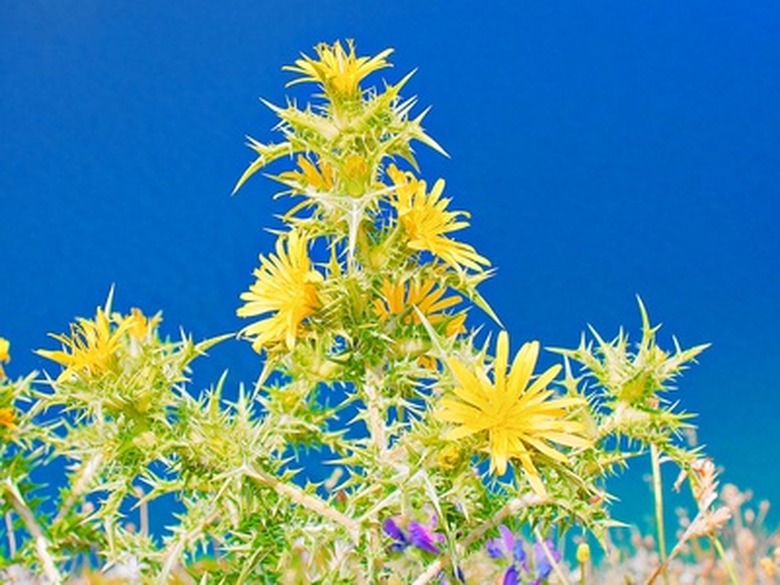What Is The Ratio Of Roundup Weed Killer To Water?
The Monsanto Corporation of St. Louis, Missouri, markets Roundup, an herbicide containing the active ingredient glysophate. Roundup is a systemic herbicide, meaning it travels through the vascular system of plants, inhibiting the division of cells. It is non-selective, meaning it kills everything. The amount of Roundup added to water depends on the weeds being killed.
Roundup to Water Ratios
The product label gives the ratio of Roundup to water in strengths ranging from .5 percent to 10 percent. Two tbsp. equal 1 fluid oz. The recommended strengths are for handheld sprayers. The strength of Roundup to water varies with the species of weed that needs to be killed. For a detailed listing of weeds and required strength of Roundup, see the product label posted online by the University of Montana.
- The Monsanto Corporation of St. Louis, Missouri, markets Roundup, an herbicide containing the active ingredient glysophate.
- The strength of Roundup to water varies with the species of weed that needs to be killed.
These proportions, in larger amounts, are also used in aerial and other forms of spraying for pastures and fields; the label gives the appropriate strengths and amounts per acre for specific weeds.
The following ratios are for the amount of Roundup to gallons of water:
For a .5 percent solution, mix .7 oz. to 1 gallon, 1 pint to 25 gallons and 2 qt. to 100 gallons.
For a 1 percent solution, mix 1.3 oz. to 1 gallon, 1 quart to 25 gallons and 1 gallon to 100 gallons.
- These proportions, in larger amounts, are also used in aerial and other forms of spraying for pastures and fields; the label gives the appropriate strengths and amounts per acre for specific weeds.
- to 1 gallon, 1 pint to 25 gallons and 2 qt.
For a 1 1/2 percent solution, mix 2 oz. to 1 gallon, 1 ½ qt. to 25 gallons and 1 ½ gallons to 100 gallons.
For a 2 percent solution, mix 2.7 oz. to 1 gallon, 2 qt. to 25 gallons, and 2 gallons to 100 gallons.
For a 5 percent solution, mix 6 ½ oz. to 1 gallon, 5 qt. to 25 gallons and 5 gallons to 100 gallons.
- For a 1 1/2 percent solution, mix 2 oz.
- For a 5 percent solution, mix 6 ½ oz.
For a 10 percent solution, mix 13 oz. to 1 gallon, 10 qt. to 25 gallons and 10 gallons to 100 gallons.
Hard Water
For drought conditions or hard water, adding 1 to 2 percent of ammonium sulfate by weight, equivalent to 8.5 to 17 lbs. per 100 gallons of water, may increase the performance of Roundup. If dry ammonium sulfate is used, it should be completely dissolved in the tank before adding Roundup. After the tank and spray system are used, they should be rinsed with cold water to reduce corrosion.
- For a 10 percent solution, mix 13 oz.
- per 100 gallons of water, may increase the performance of Roundup.
Surfactants
Surfactants are wetting agents that reduce the surface tension of water, allowing Roundup to more efficiently cover plants. If a wetting agent contains 70 percent active surfactant, add a .5 percent concentration or 2 qt. per 100 gallons of spray solution. If the wetting agent contains less than 70 percent active surfactant, add a 1 percent concentration or 4 qt. per 100 gallons of solution.
Mixing Procedure
Mix Roundup powder with water to make a slurry. Mix liquid Roundup with an equal part of water. If a Roundup that may be emulsified is used, mix one part of Roundup with two parts of water.
- Surfactants are wetting agents that reduce the surface tension of water, allowing Roundup to more efficiently cover plants.
- If a wetting agent contains 70 percent active surfactant, add a .5 percent concentration or 2 qt.
Fill the tank half full of water through a 20- to 35-mesh screen and begin agitating. If ammonium sulfate is used, add it slowly and continue agitating until it is dissolved.
Add Roundup slowly to the tank while continuing to agitate.
Add surfactant or additives that reduce the drift of spray. Continue agitating while filling the tank.
Warning
Roundup is a toxic if it is inhaled or ingested. Precautions needed to be taken in its preparation and application. There are necessary precautions to protect the natural environment. The manufacturer's recommendations for all these issues are addressed in the product label posted online by the University of Montana.
- Fill the tank half full of water through a 20- to 35-mesh screen and begin agitating.
- If ammonium sulfate is used, add it slowly and continue agitating until it is dissolved.
